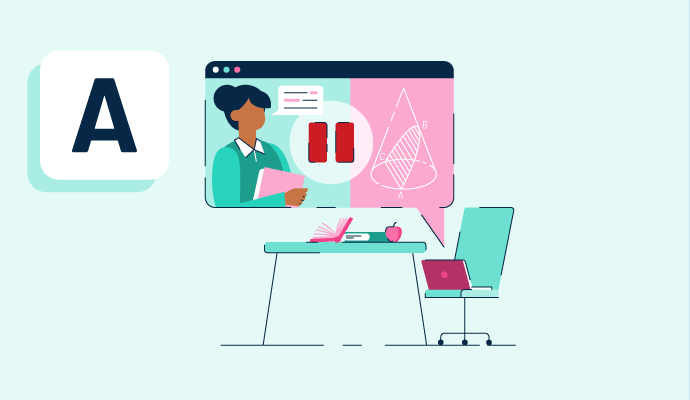What is asynchronous learning?
Asynchronous learning is an educational method in which students don’t have to attend live classes with instructors or classmates. Instead, they can explore course materials at a time of their choice under guidance from a teacher.
Asynchronous learning is becoming increasingly popular since it provides increased freedom for instructors and learners. Both parties interact, and learners can collaborate with each other, but there’s no set time or physical location.
While asynchronous learning also includes methods like tangible textbooks and articles, digital delivery is more common. Virtual classroom software makes it easy for instructors to provide videos, share documents, and connect with learners.
Benefits of asynchronous learning
Many homeschool programs, university courses, and corporate trainers offer asynchronous learning as an option. Organizations and students alike often prefer asynchronous learning due to these benefits:
- Flexibility and convenience. Students learn on their own schedule, fitting their education around work, family, and social commitments. Early risers may complete an assignment in the morning, while others might have to do it after work.
- Personalization. Since asynchronous learning offers various learning materials, instructors can choose the ones they feel would work best for each individual’s learning needs. Or, they can provide students with various ways to absorb the same content, such as watching a video or reading a text.
- Accessibility. Students who have busy schedules, live in remote areas, or are homebound can access learning materials at their own pace. They don’t need to physically attend classes to get the most out of their education.
- Cost. Asynchronous learning is often more cost-effective to create and deliver. The program doesn’t have the overhead associated with traditional education, such as renting a brick-and-mortar building. Plus, once an instructor makes online videos or modules, they can reuse them for future course sessions, decreasing the time and labor investment.
Asynchronous learning activities
Many organizations and students opt for asynchronous learning due to the wide variety of engaging techniques it offers. Asynchronous learning activities include:
- Pre-recorded videos. Instead of live video calls students must attend, asynchronous learning often involves watching pre-recorded lectures or voiceover video slideshows. Unlike live lectures, students can replay these videos to improve their comprehension and retention.
- Reading. Students read online texts and then answer questions or write essays to demonstrate their learning. With many virtual learning platforms, students can still annotate these texts, marking them up with highlighting, underlining, and notes.
- Games. To make asynchronous learning more exciting, some platforms incorporate interactive, single-player games. Learners try to achieve a specific score and earn badges and prizes to encourage engagement.
- Online assessments. To show what they’ve learned, students take interactive quizzes. These tests can be multiple-choice, short-answer, or essay.
- Discussion boards. In a classroom setting, teachers often use class discussions to increase understanding and practice discourse skills. In asynchronous learning, students can contribute to online forums or discussion boards on their own time, adding responses to ongoing threads.
Asynchronous learning best practices
Just like with traditional learning methods, students can have a positive or negative experience with an asynchronous course, depending on how it’s designed and managed. Some best practices for asynchronous learning include:
- Setting expectations. Asynchronous learning allows for increased flexibility, but it should still build a clear learning path or structure for students to follow. Instructors should create a syllabus that outlines the learning plan and provides clear expectations for how students will complete and submit assignments.
- Using calendars and notifications. While students can watch videos and complete tasks at any time, asynchronous classes still have due dates for assignments and tests. Instructors should encourage students to use a physical or virtual calendar and send them notifications ahead of major deadlines. Depending on an organization's online learning platform, providing these reminders might be as easy as ticking a box during registration.
- Communicating feedback. Providing comments about students’ performance lets them know how they’re doing and shows them how to improve. Effective feedback is specific. Instead of saying, “Well done,” instructors should leave comments explaining exactly what a student did well or what they might want to work on. In an asynchronous environment, this improves student confidence and satisfaction because they feel the instructor “sees them” and cares about their learning.
- Encouraging collaboration. Without collaboration, asynchronous learning can sometimes feel isolating. Encouraging collaboration through asynchronous group projects, email discussions, and discussion forums helps students engage more in learning and actively pushes their thinking.
Want to add a live component to your asynchronous model? Consider blended learning.

Kelly Fiorini
Kelly Fiorini is a freelance writer for G2. After ten years as a teacher, Kelly now creates content for mostly B2B SaaS clients. In her free time, she’s usually reading, spilling coffee, walking her dogs, and trying to keep her plants alive. Kelly received her Bachelor of Arts in English from the University of Notre Dame and her Master of Arts in Teaching from the University of Louisville.


















